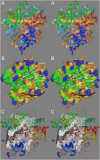Cytochrome P450-mediated metabolism of vitamin D
- PMID: 23564710
- PMCID: PMC3927478
- DOI: 10.1194/jlr.R031534
Cytochrome P450-mediated metabolism of vitamin D
Abstract
The vitamin D signal transduction system involves a series of cytochrome P450-containing sterol hydroxylases to generate and degrade the active hormone, 1α,25-dihydroxyvitamin D3, which serves as a ligand for the vitamin D receptor-mediated transcriptional gene expression described in companion articles in this review series. This review updates our current knowledge of the specific anabolic cytochrome P450s involved in 25- and 1α-hydroxylation, as well as the catabolic cytochrome P450 involved in 24- and 23-hydroxylation steps, which are believed to initiate inactivation of the vitamin D molecule. We focus on the biochemical properties of these enzymes; key residues in their active sites derived from crystal structures and mutagenesis studies; the physiological roles of these enzymes as determined by animal knockout studies and human genetic diseases; and the regulation of these different cytochrome P450s by extracellular ions and peptide modulators. We highlight the importance of these cytochrome P450s in the pathogenesis of kidney disease, metabolic bone disease, and hyperproliferative diseases, such as psoriasis and cancer; as well as explore potential future developments in the field.
Keywords: 1,25-(OH)2D3; CYP24A1; CYP27A1; CYP27B1; CYP2R1; chronic kidney disease; idiopathic infantile hypercalcemia; regioselectivity; vitamin D analog; vitamin D-dependent rickets.
Figures







References
-
- DeLuca H. F. 1974. Vitamin D: the vitamin and the hormone. Fed. Proc. 33: 2211–2219 - PubMed
-
- Fraser D. R., Kodicek E. 1970. Unique biosynthesis by kidney of a biologically active vitamin D metabolite. Nature. 228: 764–766 - PubMed
-
- Hewison M., Adams J. S. 2011. Extrarenal 1α-hydroxylase. In Vitamin D. 3rd edition. D. Feldman, J. W. Pike, and J. S. Adams, editors. Academic Press, San Diego, CA. 777–806.
-
- Jones G., Strugnell S., DeLuca H. F. 1998. Current understanding of the molecular actions of vitamin D. Physiol. Rev. 78: 1193–1231 - PubMed
Publication types
MeSH terms
Substances
Supplementary concepts
LinkOut - more resources
Full Text Sources
Other Literature Sources
Medical

